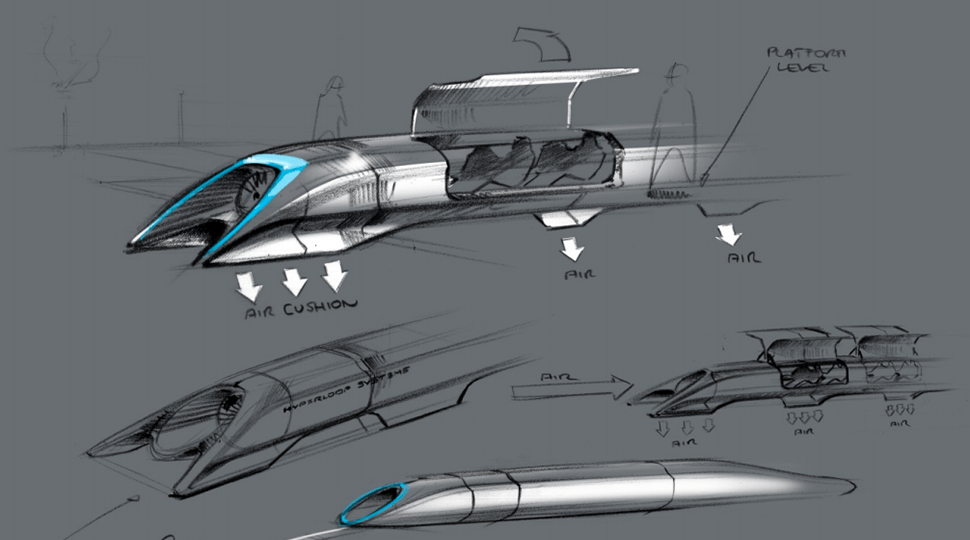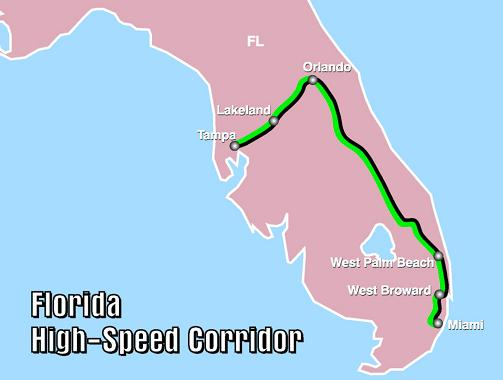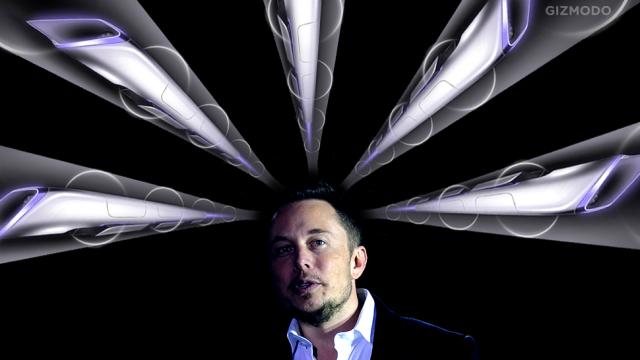As enamoured as you are with the idea, your gut says that Elon Musk’s Hyperloop is never going to happen. The good news is that the tech, according to experts we’ve talked to, is actually feasible. That bad news? That might not matter. Musk’s plan is futuristic, beautiful, and sound. It just might be more ambitious than the problem he’s is trying to solve.
One undeniable truth about Hyperloop is that it got our attention. Blazing fast travel from San Francisco to Los Angeles, built at a fraction of the cost of the proposed high-rail line making the same trek. And that name. Where do I sign up?
Besides, if anyone could pull it off, it’s Musk. Our technological concerns are so petty sometimes, and this guy thinks huge. Unlike the powerless dreamers who throw crazy ideas out there, Musk has the cachet to be taken seriously, and the money to make sure people listen.
So let’s start with the encouraging part. The part where Hyperloop actually makes sense.
Beats What We’ve Got
To understand Hyperloop, it’s important to understand why it exists in the first place. It’s an answer to a simple question: Are trains really the best we can do? Because, as anyone who’s ever had an Amtrak ticket punched knows, trains in the United States are awful.
Trains failed in America because they’re expensive and not really better than the alternatives. Amtrak’s “high-speed” Acela trains are a prime offender. They’re way more expensive than just the regular train (which itself is often more expensive than a plane to begin with), and on a trip from Washington DC to New York, it saves you a grand total of about a half-hour.
“For high-speed transit to catch on it’s got to be better than the bus,” says Andrea Marpillero-Colomina, a fellow in the in the Public and Urban Policy program at the The New School. “The bus sucks.” Some people like Amtrak from New York to DC, but there’s a reason so many successful bus companies have cropped up in the last decade covering the same route. They’re not great. But the train is not good enough to justify the cost.
Among countries with established intrastate transit systems, bad trains are also a uniquely American problem. Amtrak lacks the speed as well as the cool jetsetting feel of trains in Europe and Japan. Consider this admittedly cheesy advertisement concept video for the Frecciarossa 1000 train, which is on the tracks now in Italy. If this is the Ferrari of trains, the Acela is a beat-up Pinto.
And yet the proposed high-speed rail line in California isn’t a big enough step forward by many accounts. It’s not using the fancy magnetic levitation technology being implemented in places like Japan and Germany, which will allow trains to fly down the tracks at over 480km/h. The trip from San Francisco to Los Angeles would take 2 hours and 38 minutes, an average speed of 260km/h, which is pretty zippy compared to what we’ve had in the United States before, but not all that impressive by global standards. And as Musk points out, it’s not even really energy-efficient, when you consider the per-passenger energy expenditure.
The grand total? $US70 billion, which is a lot of money to spend on anything, but especially on yesterday’s tech. Musk sees the plan as a huge waste of money, and thus the Hyperloop: 1127km/h, 35 minutes, $US6 billion and energy neutral. Shin-pei Tsay, Director of Research and Development the startup TransitCenter sums up Musk’s response to high-sped rail. “It’s an extreme solution to an unacceptable situation.” It sounds like the future we deserve — and on paper it’s a future we could have too.
Full Speed Ahead

What’s most encouraging about Musk’s plans is that as futuristic as they seem in aggregate, there’s nothing especially new about them when broken down piece by piece. Conceptually, he’s drawing on more than a century of research into pneumatic trains, and thousands of kilometre-per-hour transit. In fact, his 1126km/h goal is relatively conservative compared to the theoretical limits of for tubed transit.
The proposal’s key technologies, though, are pretty straightforward: a low-pressure tube, a powerful air compressor, solar panels, linear induction motors and a large elevated structure built on pylons. According to Scott Marshall, an engineer at the National Magnetic Field Laboratory in Florida (which designs and builds some of the world’s largest magnets for research institutions), “it all seems physically possible” from a technical point of view. These are all deployed and proven technologies — Musk’s just putting them together in a unique, and frankly, ingenious way.
Another concern is scale; while Hyperloop might work on paper, or even as a prototype, how would you implement it over hundreds of kilometres in populated areas? It seems overwhelming. It shouldn’t.
“I’ve been to CERN… These are big, high-concept, unprecedented projects that have been completed,” explained Marshall in a phone interview. And it’s not just a massive particle accelerator. It’s the Mars Rover program, the Apollo missions, ARPANET and countless other examples of ambitious, previously unthinkable goals that were conceived and then executed.
In fact, you don’t even need to look to outer space or the Higgs boson. A project of this exact type and of this magnitude is already happening on this scale — just not in the United States. Japan’s in the process of creating the next generation of its massive bullet train system, capable of top speeds well north of 480km/h. How did they do it? “The trains are Japan’s space program,” says Marshall. Hyperloop could be a complement to ours.
To be clear, there are some technical quibbles; some experts, for instance, are already pointing out that Hyperloop’s air compressors generate more heat than Musk is accounting for.
But it’s important to remember that Musk’s white paper is an alpha design. He’s not saying “This is exactly how this should work.” He’s saying, “I think we can blast people through tubes from San Francisco to Los Angeles, and here’s how it might work — discuss.” As technologies and plans are developed, they change along the way, but with enough resources, there’s no reason this couldn’t be accomplished.
At least, no technological one.
Money Only Goes So Far
An underplayed part of Hyperloop’s appeal isn’t just that it’s achievable; it’s also, Musk insists, affordable. He’s operating under the assumption that the only reason people will want to try his technology instead of another is because it will save money and energy. That’s why he went with the more affordable air bearings instead of magnetic levitation, and why he’s positioning it as a $US6-10 billion counterpoint to California’s proposed $US70 billion high-speed rail project.
Musk’s reasoning makes sense to a point; these are days of austerity, and big public expenditures are bad politics. Then again, so are technological gambles, cost overruns, and eminent domain. All of which will come part and parcel with the Hyperloop package.
If the Hyperloop doesn’t happen, it won’t be because of the proposed price tag. It’ll be because convincing people and the government that this is a good enough idea will be very tough.

At least, that’s why Marshall from the magnetic laboratory is sceptical. “These projects require a large public sector commitment,” he explained, with an illustration from his own recent history. During the aughts, there was a serious proposal to build a state-of-the-art, 520km maglev train line in Florida from Tampa to Miami. The plan got $US2.4 billion in federal funding, but died a political death when Governor Rick Scott refused the money. It wasn’t just a problem of proving to people that it would be good transit. The plan just didn’t have the public support to make it happen.
And even if you do build enough political goodwill, it won’t necessarily cut through the red tape. Dave King, a professor of Urban Planning at Columbia University, told me he’s surprised Musk’s proposal doesn’t mention a regulatory structure for the project, which Hyperloop will almost certainly require.
Cars, air travel, trains, are all tediously regulated, and that’s a good thing because it makes them safe — and whoever is building this will want to be damn sure its safe. The Concorde was grounded for over a year after its infamous 2000 crash. More recently, the long-delayed, over-budget Boeing 787 Dreamliner’s mass deployment has been repeatedly delayed because it can’t stop spontaneously catching fire. And these incidents all happened despite an intensive regulatory framework designed specifically to prevent them.
Now imagine creating an entirely new regulatory structure for an entirely new technology. What regulatory body would Hyperloop even fall under? Everything from the design of the tubes to the pods need to be exhaustively tested, not just by the designers, but also by the government. And that’s going to require a level of political will — and taxpayer money — that only massive public support or Kennedy-like leadership can generate. Musk cannot do this by the force of his personality — or wallet — alone.
In fact, this is exactly why that proposed high-speed rail line might still seem preferable even after Hyperloop’s introduction. Trains are conservative. They’re not too fast, they use technology we’re familiar with, they stop frequently enough to make everyone happy. A known quantity is always an easier sell.
Travel Without a Cause?

There needs to be a serious conversation about whether the Hyperloop is even something that people need or want. In order for people to embrace high-speed transit it’s got to be some combination of cheaper, faster, and more comfortable than what came before it. That’s why high-speed transit works in Europe, and it’s Hyperloop’s only chance of succeeding here.
Currently, driving from San Francisco to Los Angeles ain’t cheap; figure $US50 depending on gas prices and fuel efficiency. If Musk can pull off the Hyperloop for $US105 a ticket like he says he can, it would be competitively priced, but not overwhelmingly so given that an hour-long flight from SF to LA costs under $US200, day of. According to King, Hyperloop may be the solution to a problem no one actually has: “It’s not all that clear that time-saving is all that big of a deal. It’s not that hard to get from San Francisco to Los Angeles.”
Indeed, take a look at the numbers, and you start to wonder if the money wouldn’t be better spent on regional transit. The estimated daily ridership for the California High Speed Rail is 260,000 people, which is pretty middling considering that the San Francisco’s BART alone moves some 380,000 people every day. What’s more, Hyperloop would only serve a fraction of that 260,000 population because it doesn’t include all of the intermediate stops.
And even if Hyperloop did save you enough time and money to make it a viable option, what kind of ride would it be? Musk’s technology may be sound, but beyond explaining that a trip in one of his pods won’t be a wild, vomit-inducing pain, he hasn’t addressed issues like, say, comfort. Or legroom. Or how and where one might pee.
In its current incarnation, Hyperloop feels coldly efficient, like Musk is stuffing you in a can and shooting you down a windowless tunnel of doom. When you think about the future you want, it’s usually got a view doesn’t it? Speed is one thing, but as King points out, no one will ride something if it feels like you’re being shunted through a tube like a bullet. “You only want to feel speed in a convertible.”
Musk’s plan should be heavily discussed and carefully considered. It’ll be exciting to see how subsequent designs push the idea even further, refining and perfecting an already sound idea. The technological ambition and courage behind Hyperloop are unimpeachable. Ambition, know-how, and funding don’t mean a thing if you don’t have the right kind of support. And right now, it’s hard to see how Musk gets it.
Top picture: Michael Hession via Getty Images and Tesla Motors
